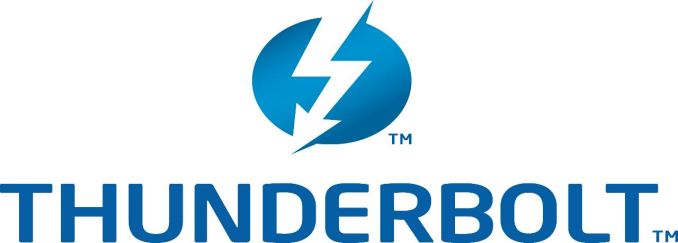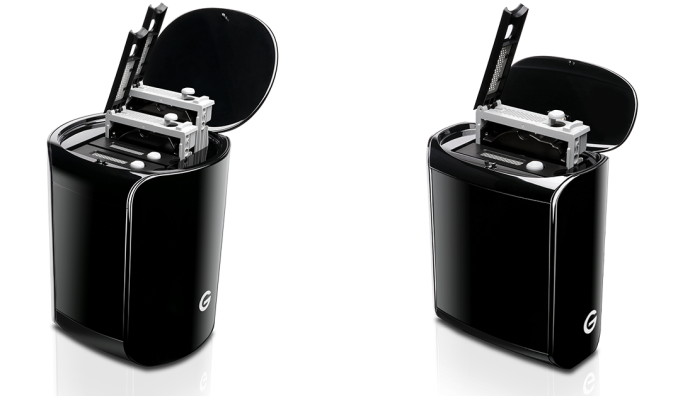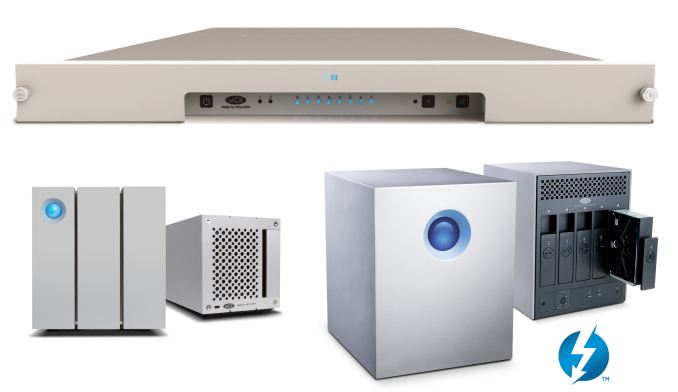G-Technology and LaCie Roll Out Thunderbolt 2 Lineup
by Ganesh T S on April 11, 2014 5:44 AM EST- Posted in
- Storage
- LaCie
- G-Technology
- Thunderbolt 2

Thunderbolt is Intel’s high-bandwidth, do-everything connector, designed as a potential future path for all things external to a system - displays, USB devices, external storage, PCI Express, and even graphics cards. The first version of Thunderbolt supported up to 10Gb/s bandwidth (uni-directional) for each port (double that of USB 3.0, but at a much higher implementation cost). Thunderbolt 2 doubled the bandwidth to 20 Gbps per port (bi-directional) by combining the four 10Gb/s channels into two 20Gb/s channels, thus enabling support for 4Kp60 raw video transfer (which may need up to 15 Gbps). Motherboards with Thunderbolt 2 certification started rolling out in the second half of 2013, but peripherals capable of taking advantage of Thunderbolt 2 were quite rare.
We were expecting a number of Thunderbolt 2 products at CES, but were able to get hands-on time with only a pre-production sample of the LaCie Little Big Disk Thunderbolt 2. With 4K being one of the main drivers for Thunderbolt 2, manufacturers have used the time around the 2014 NAB Show (the B2B media / broadcast trade show) to add new members to their Thunderbolt portfolio.
One of the interesting aspects to note is that the cutting-edge Thunderbolt products are being marketed through the premium brands/subsidiaries of the two major hard drive manufacturers. Representing Western Digital, we have G-Technology, a division of HGST (a wholly owned subsidiary of WD). Seagate is represented by LaCie. These products are also equipped with the latest high-capacity 6TB enterprise class drives.
G-Technology STUDIO SERIES:
G-Technology introduced two members, the G-SPEED Studio and the G-RAID Studio. The G-SPEED is a four-bay solution with a built-in RAID controller (hardware RAID) and dual Thunderbolt 2 ports (for daisy chaining). RAID 0,1,5 and 10 are supported, and the drives are user-replaceable. Performance tops out at 660 MBps in RAID 0. Pricing ranges from $2200 for the 12TB version to $3600 for the 24TB version.
The G-RAID is a 2-bay solution with hardware RAID (user-selectable RAID 0,1 or JBOD). It features two Thunderbolt 2 ports for daisy chaining and performance tops out at 360 MBps in RAID 0. Pricing ranges from $650 for the 4TB version to $1500 for the 12TB version.
Both products claim compatibility with both Mac OS 10.9+ and Windows 7+. They will be available in May and carry a 3-year warranty.
LaCie 2BIG, 5BIG and 8BIG RACK:
LaCie announced three Thunderbolt 2 products at the 2014 NAB. The 2BIG is a two-bay hardware RAID unit similar to the G-RAID, but, in addition to the Thunderbolt 2 interfaces, it also sports a USB 3.0 port. With two 6TB 7200rpm drives in RAID 0, LaCie claims speeds up to 420 MBps.
The 5BIG is a 5-bay hardware RAID unit with two Thunderbolt 2 ports (for daisy chaining). Equipped with 6TB Seagate hard drives, it can hit up to 1050 MBps. The 8BIG RACK is a 1U rackmount solution and provides up to 48TB of direct attached storage. LaCie claims speeds of up to 1330 MBps with this unit.
While the 2BIG enjoys Windows compatibility, thanks to the USB 3.0 port, LaCie is still working on Windows support for the other models (They are currently Mac OS 10.8.5+ only). All units have hot-swappable drives. Availability is slated for this quarter, and pricing is yet to be announced.
Before closing up this coverage, mention must also be made of Western Digital's My Passport Pro (launched at MacWorld). This bus-powered model is based on Thunderbolt (the first generation) and sports two 2.5" drives. There are two models, one with 2x 1TB drives and another with 2x 2TB drives. Drives can be configured in RAID 0,1 or JBOD. The units appear to be compatible with Macs only. Pricing comes in at $300 for the 2TB version and $450 for the 4TB version.












24 Comments
View All Comments
Morawka - Friday, April 11, 2014 - link
Seems like companies are unwilling to sell Thunderbolt devices at a reasonable 30% profit margin. Nah since it's thunderbolt, they gotta double their money.Tray Price is $10 for TB 2.0.. come-on guys
nathanddrews - Friday, April 11, 2014 - link
This is probably a dumb statement, but I wonder how TB pricing will be affected by 10GbE pricing in the coming years. Right now to get RJ45-compatible 10GBE devices, you're looking at $300-600 for a NIC and $500-3,000 for a switch. Seems like if you want to get above the 1GbE speed limit, you need to spend considerably more for either LAG-enabled devices, 10GbE devices, or TB devices. Even (good) 802.11ac equipment has been pretty expensive compared to 802.11n.ddriver - Friday, April 11, 2014 - link
The two don't really compete, so why would it affect 10 GbE pricing? Did USB 3 affect it? Even though it is 5 gbit?nathanddrews - Friday, April 11, 2014 - link
Because Intel is marketing TB as a 10GbE alternative:http://arstechnica.com/gadgets/2014/04/intel-expan...
ddriver - Friday, April 11, 2014 - link
This is not ethernet, you can establish p2p communication via USB 3 as well, but unlike ethernet, you cannot have neither long cables, nor multiple hosts. It is an alternative for "fast connection between two PCs" but certainly not an alternative to "10 gbit ethernet", more like it sounds like a "cheap" way to connect two PCs without investing in 10 gbit network hardware.457R4LDR34DKN07 - Friday, April 11, 2014 - link
but unlike ethernet, you cannot have neither long cableshttp://www.corning.com/opcomm/OpticalCablesbyCorni...
200ft is pretty long.
ddriver - Saturday, April 12, 2014 - link
Yeah, and 10 meters of the optical TB2 cable costs 330$... 330$ for the cable only? For this money, you can get an actual 10 GbE adapter... I don't even want to know how much 200 ft will cost...ddriver - Saturday, April 12, 2014 - link
Also, the 100 ft cable is 660$. 30 meters of cable at the price of two 10 GbE adapters... how very "neat" and "competitive".Black Obsidian - Friday, April 11, 2014 - link
I can see the logic involved in their pricing. Basically the only people with Thunderbolt functionality are Mac owners, who are accustomed to paying very healthy margins for their hardware. It's extremely high-quality hardware, no doubt, but the margins on it are high. That being the case, they can be reasonably expected to pay the same margins on supporting hardware as well, especially relatively-rare items like Thunderbolt (2) devices.Morawka - Friday, April 11, 2014 - link
If they would lower prices it would become more mainstream. Its a vicious cycle. One of two factors has to break for it to go mainstream.. Price or Availability.